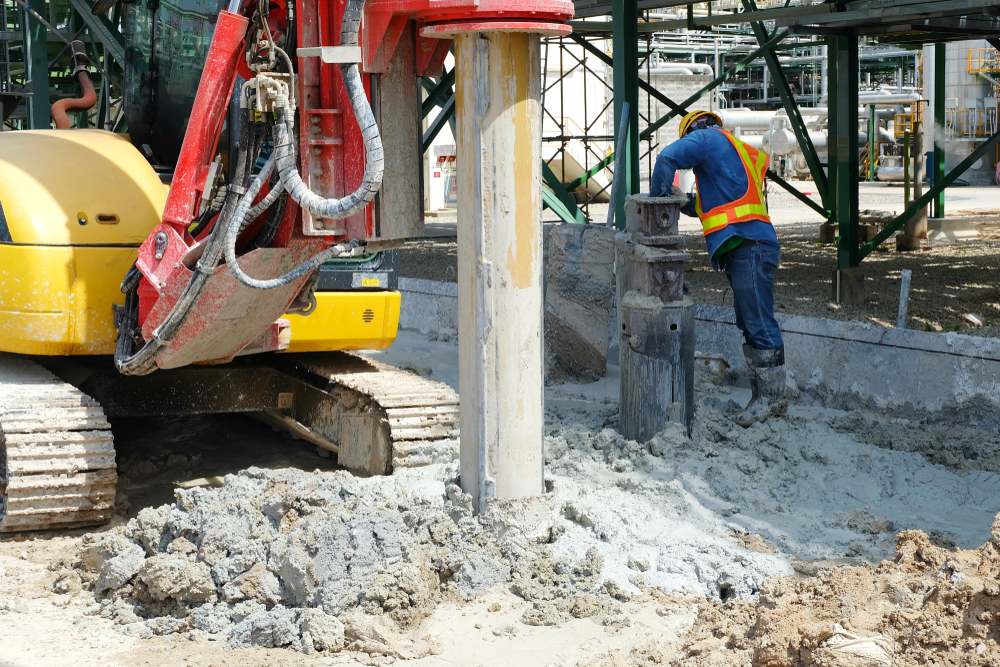The Main Principles Of Geotechnical Engineering For Construction Projects
The Main Principles Of Geotechnical Engineering For Construction Projects
Blog Article
Geotechnical Engineering For Construction Projects Things To Know Before You Get This
Table of ContentsWhat Does Geotechnical Engineering For Construction Projects Do?Not known Facts About Geotechnical Engineering For Construction ProjectsGeotechnical Engineering For Construction Projects Things To Know Before You Get ThisThe Best Guide To Geotechnical Engineering For Construction ProjectsThe Geotechnical Engineering For Construction Projects Diaries
Consequently, during the examination, it is essential to pierce at the required deepness and the required variety of holes according to the recommendation of the Canadian Structure Layout requirement. Often, the owner might conserve some Geotechnical Investigation price yet wind up investing greater than the prepared for throughout the building cost.The obligations of the geotechnical specialist entail supplying material testing for building and construction support. Geotechnical Engineering for Construction Projects. Geotechnical engineers evaluate all the field examination reports to ensure that building is going on according to the project specification. Throughout building and construction, a confirmatory test for dirt compaction is done on-site to guarantee that no future negotiation occurs
After the concrete is put -7 days and 28 days- tests are performed on concrete examples accumulated from the site to guarantee that the concrete put fulfills the design criterion. Asphalt core is taken after the Asphalt is laid and compressed to confirm that it fulfills the style requirement. All lab examination records are analysed by the Geotechnical Designer to guarantee that it satisfies the project spec.
The Geotechnical Engineering For Construction Projects Diaries

Geotechnical design plays a vital function in guaranteeing the security of construction projects. Geotechnical design is an important branch of civil design that concentrates on recognizing the behavior of earth products, such as dirt and rock.

For a trustworthy foundation and a smooth building procedure, depend offer the proficiency you require. Call to get expert advice and geotechnical solutions customized to your next job.
The Buzz on Geotechnical Engineering For Construction Projects
When starting a land development task, comprehending the ground below your feet is as important as the structures you intend to construct above it. Our Geotechnical Engineering group evaluate the ground, guaranteeing it is appropriate for the proposed growth while giving you with the details needed to satisfy your task goals.
Geotechnical Design takes a look at the development of the ground, as it is the foundation for all jobs. Where structures require to be created relative to the ground conditions; ground conditions (e.g., soft ground) might require enhancing depending on the dimension of the designated framework. Before building, you need to learn about the groundwater, soil framework, and liquefaction possibility of your land.
For websites that are not linked on the regional authority framework added site examinations would be needed to offer technological inputs for on-site stormwater and wastewater. We have actually experienced Geotechnical Designers based in each office, sustaining your geotechnical requirements across the country. Connect to us to review exactly how we can support your next job.
These records are customized to satisfy the particular needs of a job and consist of layout parameters and recommendations for the building of a variety of man-made frameworks. As well as providing working as a consultant solutions covering locations such as incline security and load-bearing abilities for various products, these designers undertake r & d activities to enhance methodologies, tools, materials expertise and analysis covering whole lifecycles.
The 9-Second Trick For Geotechnical Engineering For Construction Projects

Nevertheless, rates of pay typically enhance as your understanding and abilities grow, with guidelines aiming to a graduate beginning salary of in between 18,000 and 28,000 per year in the UK. This climbs to 26,000 to 36,000 with a couple of years of experience and afterwards reaching 40,000 to 60,000+ for senior, legal or master designers.
However, with the right application it is feasible to grasp the profession and gain entrance to a challenging yet rewarding and crucial career. A geologist would certainly need to re-train to end up being a geotechnical designer, although there is a lot of cross-over in between both careers, which can make this easier - Geotechnical Engineering for Construction Projects. Geologists need to have an understanding of dirts, rocks and other materials from a clinical perspective, while geotechnical designers story their expertise of matters such as soil and rock auto mechanic, geophysics and hydrology and use them to design and ecological projects
When beginning, these engineers will certainly have a tendency to work with less complicated tasks, developing knowledge and experience prepared for more difficult job later. Geotechnical designers often tend to pop over here be experts in particular locations as they grow in experience, concentrating on specific infrastructures such as trains, roadways or water. These designers likewise work with renewable resource, offshore and onshore oil and gas, nuclear power, and much more.
4 Simple Techniques For Geotechnical Engineering For Construction Projects
The time taken to come to be a More hints geotechnical engineer depends on where you are based, where you research and what level of education and learning you desire to acquire before going into the office. Generally-speaking it takes 3-4 years to reach the basic needs to begin an occupation as a geotechnical engineer.
These operations enable professionals to assess a host of dirt technicians consisting of weight, porosity, void-to-solid fragment proportion, permeability, compressibility, optimum shear strength, bearing ability and deformations. If the framework calls for a deep structure, designers will make use of a cone penetration examination to approximate the amount of skin and end bearing resistance in the subsurface.
When examining an incline's balance of shear anxiety and shear stamina, or its capability to withstand and undergo motion, rotational slides and translational slides are typically taken into consideration. Rotational slides fail along a curved surface, with translational slides taking place on a planar surface area. An expert's Going Here objective is to determine the conditions at which an incline failing might take place.
Typically, findings recommend that a site's soil ought to be treated to enhance its shear stamina, tightness and leaks in the structure before layout and building. When it comes time to set out structure strategies, professionals are significantly concentrated on sustainability, even more particularly just how to lower a structure's carbon impact. One technique has actually been to replace 20 percent of a structure's cement with fly ash, a waste product from coal fire nuclear power plant.
Report this page